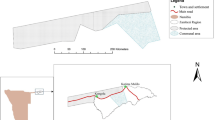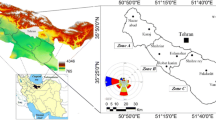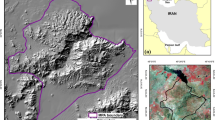Abstract
Protected areas of Romania have enjoyed particular importance after 1989, but, at the same time, they were subject to different anthropogenic and natural pressures which resulted in the occurrence of land cover changes. These changes have generally led to landscape degradation inside and at the borders of the protected areas. In this article, 12 landscape metrics were used in order to quantify landscape pattern and assess land cover changes in two protected areas, Piatra Craiului National Park (PCNP) and Bucegi Natural Park (BNP). The landscape metrics were obtained from land cover maps derived from Landsat Thematic Mapper (TM) and Landsat Enhanced Thematic Mapper Plus (ETM+) images from 1987, 1993, 2000, 2009 and 2010. Three land cover classes were analysed in PCNP and five land cover map classes in BNP. The results show a landscape fragmentation trend for both parks, affecting different types of land covers. Between 1987 and 2010, in PCNP fragmentation was, in principle, the result not only of anthropogenic activities such as forest cuttings and illegal logging but also of natural causes. In BNP, between 1987 and 2009, the fragmentation affected the pasture which resulted in the occurrence of bare land and rocky areas because of the erosion on the Bucegi Plateau.










Similar content being viewed by others
References
Abrudan, I. V., Marinescu, V., Ionescu, O., Ioras, F., Horodnic, S. A., & Sestras, R. (2009). Developments in the Romanian forestry and its linkages with other sectors. Notulae Botanicae Horti Agrobotanici Cluj-Napoca, 37(2), 14–21.
Abrudan, I. V. (2012). A decade of non-state administration of forests in Romania: achievements and challenges. International Forestry Review, 14(3), 275–284.
Piatra Craiului National Park Administration (2011). Management Plan of Piatra Craiului National Park (in Romanian). http://www.pcrai.ro//files/Plan_site.pdf. Accessed 20 Jan 2015.
Bucegi Natural Park Administration, (2011). Management plan of Bucegi Natural ark (in Romanian). http://www.bucegipark.ro/informatii.php?show=plan. Accessed 20 Jan 2015.
Baldi, G., Guerschman, J. P., & Paruelo, J. M. (2006). Characterizing fragmentation in temperate South America grasslands. Agriculture, Ecosystems and Environment, 116(3), 197–208.
Batistella, M., Robeson, S., & Moran, E. F. (2003). Settlement design, forest fragmentation, and landscape change in Rondônia, Amazonia. Photogrammetric Engineering and Remote Sensing, 69(7), 805–812.
Bracchetti, L., Carotenuto, L., & Catorci, A. (2012). Land-cover changes in a remote area of central Apennines (Italy) and management directions. Landscape and Urban Planning, 104(2), 157–170.
Chavez Jr., P. S. (1996). Image-based atmospheric corrections—revisited and improved. Photogrammetric Engineering and Remote Sensing, 62(9), 1025–1036.
Congalton, R. G., & Green, K. (2009). Assessing the accuracy of remotely sensed data: Principles and practices. London: CRC Press Taylor & Francis Group.
Coppedge, B. R., Engle, D. M., Fuhlendorf, S. D., Masters, R. E., & Gregory, M. S. (2002). Landscape cover type and pattern dynamics in fragmented southern Great Plains grasslands, USA. Landscape Ecology, 16(8), 677–690.
DeFries, R., Hansen, A., Turner, B. L., Reid, R., & Liu, J. (2007). Land use change around protected areas: management to balance human needs and ecological function. Ecological Applications, 17(4), 1031–1038.
Egbert, S. L., Park, S., Price, K. P., Lee, R. Y., Wu, J., & Nellis, M. D. (2002). Using conservation reserve program maps derived from satellite imagery to characterize landscape structure. Computers and Electronics in Agricuture, 37(1–3), 141–156.
Esbah, H., Deniz, B., Kara, B., & Kesgin, B. (2010). Analyzing landscape changes in the Bafa Lake Nature Park of Turkey using remote sensing and landscape structure metrics. Environmental Monitoring and Assessment, 165(4), 617–632.
Forman, R. T. T. (1995). Land mosaics—The ecology of landscape and regions. Cambridge: Cambridge University Press.
Foster, D. R., Orwig, D. A., & McLachlan, J. S. (1996). Ecological and conservation insights from reconstructive studies of temperate old-growth forests. Trends in Ecology and Evolution, 11(10), 419–425.
Frohn, R. C. (1998). Remote sensing for landscape ecology: New metric indicators for monitoring, modeling, and assessment of ecosystems. Florida: Boca Raton, Lewis Publications.
Garbarino, M., Sibona, E., Lingua, E., & Motta, R. (2014). Decline of traditional landscape in a protected area of the southwestern Alps: the fate of enclosed pasture patches in the land mosaic shift. Journal of Mountain Science, 11(2), 544–554.
Geri, F., Amici, V., & Rocchini, D. (2010). Human activity impact on the heterogeneity of a Mediterranean landscape. Applied Geography, 30(3), 370–379.
Girvetz, E. H., Thorne, J. H., Berry, A. M., & Jaeger, J. A. G. (2008). Integration of landscape fragmentation analysis into regional planning: a statewide multi-scale case study from California, USA. Landscape and Urban Planning, 86(3), 205–218.
Ienciu, I., Dimen, L., Ludusan, N., Grecea, C., Borsan, T., & Oprea, L. (2012). Dynamics of the rill and gully erosion using GIS technologies. Journal of Environmental Protection and Ecology, 13(1), 345–351.
Iojă, C. I., Patroescu, M., Rozylowicz, L., Popescu, V. D., Verghelet, M., Zotta, M. I., et al. (2010). The efficacy of Romania’s protected areas network in conserving biodiversity. Biological Conservation, 143(11), 2468–2476.
Ioraş, F., & Abrudan, I. V. (2006). The Romanian forestry sector: privatisation facts. International Forestry Review, 8(3), 361–367.
Irland, L. C. (2008). State failure, corruption, and warfare: challenges for forest policy. Journal of Sustainable Forestry, 27(3), 189–223.
Jenkins, C. N., & Joppa, L. (2009). Expansion of the global terrestrial protected area system. Biological Conservation, 142(10), 2166–2174.
Jensen, J. R. (2007). Remote sensing of the environment: an earth resource perspective. New Jersey: Upper Saddle River, NJ: Pearson Prentice Hall.
Joern, A., & Keeler, K. H. (1995). Getting the lay of the land: introducing North American native grassland: In: Joern, A. and Keeler, K. H. (Eds.), The changing prairie: North American grasslands (pp. 11–24). New York: Oxford University Press.
Joppa, L. N., Loarie, S. R., & Pimm, S. L. (2008). On the protection of “protected areas”. Proceedings of the National Academy of Sciences, 105(18), 6673–6678.
Kintz, D. B., Young, K. R., & Crews-Meyer, K. A. (2006). Implications of land use/landcover change in the buffer zone of a national park in the tropical Andes. Environmental Management, 38(2), 238–252.
Knorn, J., Kuemmerle, T., Szabo, A., Mindrescu, M., Keeton, W. S., Radeloff, V. C., et al. (2012). Forest restitution and protected area effectiveness in post-socialist Romania. Biological Conservation, 146(1), 204–212.
Knorn, J. (2012). Studying land-use and land-cover change with high resolution data—an assessment of the Carpathian Ecoregion. PhD Thesis, Humboldt-Universität zu Berlin – Geographisches Institut: Berlin, 165 p.
Kobayashi, S., & Sanga-Ngoie, K. (2008). The integrated radiometric correction of optical remote sensing imageries. International Journal of Remote Sensing, 29(20), 5957–5985.
Kuemmerle, T., Hostert, P., Radeloff, V. C., Perzanowski, K., & Kruhlov, I. (2007). Postsocialist forest disturbance in the Carpathian border region of Poland, Slovakia, and Ukraine. Ecological Applications, 17(5), 1279–1295.
Kuemmerle, T., Chaskovskyy, O., Knorn, J., Radeloff, V. C., Kruhlov, I., Keeton, W. S., et al. (2009). Forest cover change and illegal logging in the Ukrainian Carpathians in the transition period from 1988 to 2007. Remote Sensing of Environment, 113(6), 1194–1207.
Lausch, A., & Herzog, H. (2002). Applicability of landscape metrics for the monitoring of landscape change: issues of scale, resolution and interpretability. Ecological Indicators, 2(1), 3–15.
Li, H., & Reynolds, J. F. (1993). A new contagion index to quantify spatial patterns of landscapes. Landscape Ecology, 8(3), 155–162.
Lillesand, T. M., Kiefer, R. W., & Chipman, J. W. (2008). Remote sensing and image interpretation. NewYork: JohnWiley & Sons.
Lôbo, D., Leão, T., Melo, F. P., Santos, A. M., & Tabarelli, M. (2011). Forest fragmentation drives Atlantic forest of northeastern Brazil to biotic homogenization. Diversity and Distributions, 17(2), 287–296.
Markham, B. L., & Barker, J. L. (1986). Landsat MSS and TM post-calibration dynamic ranges, exatmospheric reflectances and at-satellite temperatures. EOSAT Landsat Technical Notes, 1, 3–8.
Martinez del Castillo, E., Garcia-Martin, A., Longares Aladrén, L. A., & de Luis, M. (2015). Evaluation of forest cover change using remote sensing techniques and landscape metrics in Moncayo Natural Park (Spain). Applied Geography, 62, 247–255.
McGarigal, K., & Marks, B. J. (1995). Fragstats: spatial pattern analysis program for quantifying landscape structure. General Technical Report PNW–GTR–351. Portland OR: U.S. Department of Agriculture, Forest Service, Pacific Northwest Research Station.
Nagendra, H., Pareeth, S., Sharma, B., Schweik, C. M., & Adhikari, K. R. (2008). Forest fragmentation and regrowth in an institutional mosaic of community, government and private ownership in Nepal. Landscape Ecology, 23(1), 41–54.
Naveh, Z. (1995). Interactions of landscapes and cultures. Landscape and Urban Planning, 32(1), 43–54.
Paavola, J., Gouldson, A., & Kluvankova-Oravska, T. (2009). Interplay of actors, scales, frameworks and regimes in the governance of biodiversity. Environmental Policy and Governance, 19(3), 148–158.
Peet, R. K. (1974). The measurement of species diversity. Annual Review of Ecology and Systematics, 5, 285–307.
Pierce, S. M., Cowling, R. M., Knight, A. T., Lombard, A. T., Rouget, M., & Wolf, T. (2005). Systematic conservation planning products for land-use planning: interpretation for implementation. Biological Conservation, 125(4), 441–458.
Pôças, I., Cunha, M., & Pereira, L. S. (2011). Remote sensing based indicators of changes in a mountain rural landscape of Northeast Portugal. Applied Geography, 31(3), 871–880.
Reddy, C. S., Sreelekshmi, S., Jha, C. S., & Dadhwal, V. K. (2013). National assessment of forest fragmentation in India: landscape indices as measures of the effects of fragmentation and forest cover change. Ecological Engineering, 60, 453–464.
Simpson, E. H. (1949). Measurement of diversity. Nature, 163(4148), 688.
Soran, V., Biro, J., Moldovan, O., & Ardelean, A. (2000). Conservation of biodiversity in Romania. Biodiversity and Conservation, 9(8), 1187–1198.
Southworth, J., & Tucker, C. (2001). The influence of accessibility, local institutions, and socioeconomic factors on forest cover change in the mountains of western Honduras. Mountain Research and Development, 21(3), 276–283.
Tereşneu, C. C. (2012). Automatic data processing of geodetic data. Brasov: Transilvania University Publishing House (in Romanian).
Tudoran, G. M. (2013). Regulations regarding the management of forests included in natural protected areas. Bulletin of the Transilvania University of Braşov, Series II: Forestry, Wood Industry, Agricultural Food Engineering, 6(55)(1), 33–38.
Uuemaa, E., Mander, U., & Marja, R. (2013). Trends in the use of landscape spatial metrics as landscape indicators: a review. Ecological Indicators, 28, 100–106.
Risser, P. G., Birney, E. C., Blocker, H. D., May, S. W., Parton, W. J., & Wiens, J. A. (1981). The true prairie ecosystem. Stroudsburg, Pennsylvania: Hutchinson Ross Publishing Company.
Thuiller, W., Albert, C., Araújo, M. B., Berry, P. M., Cabeza, M., & Guisan, A. (2008). Predicting global change impacts on plant species’ distributions: future challenges. Perspectives in Plant Ecology, Evolution and Systematics, 9(3), 137–152.
Turner, M. G. (1989). Landscape ecology: the effect of pattern on process. Annual Review of Ecology and Systematics, 20, 171–197.
Turner, B. L., & Meyer, W. B. (1993). Environmental change: the human factor. In M. J. McDonnell, & S. T. A. Pickett (Eds.), Humans as components of ecosystems (pp. 40–50). New York: Springer-Verlag.
Vanonckelen, S., Lhermitte, S., & Van Rompaey, A. (2013). The effect of atmospheric and topographic correction methods on land cover classification accuracy. International Journal of Applied Earth Observation and Geoinformation, 24(1), 9–21.
Voiculescu, M. (2009). The present-day erosional processes in the alpine level of the Bucegi Mountains—Southern Carpathians. Geographic Forum. Studies and Research in Geography and Environment, VIII(8), 23–37.
Vorovencii, I., & Iordache, E. (2013). Identification and analysis of forest disturbances and fragmentation in Giurgeu Mountains, Romania, using Landsat data. In: Proceedings of the 6th international scientific conference „Rural Development 2013”, Vol. 6, Book 3, Kaunas, Lithuania, pp. 513–518.
Young, J., Richards, C., Fischer, A., Halada, L., Kull, T., Kuzniar, A., et al. (2007). Conflicts between biodiversity conservation and human activities in the central and eastern European countries. AMBIO: A Journal of the Human Environment, 36(7), 545–550.
Yuan, F., Kali Sawaya, K. E., Loeffelholz, B. C., & Bauer, M. E. (2005). Land cover classification and change analysis of the Twin Cities (Minnesota) Metropolitan Area by multitemporal Landsat remote sensing. Remote Sensing of Environment, 98(2), 317–328.
Acknowledgments
The author would like to thank the management of Piatra Craiului National Park and Bucegi Natural Park for their assistance in obtaining the material. Also, the author would like to express his gratitude to the two anonymous reviewers for their pertinent observations and comments and to Claudia Ciubancan for her support with the English language.
Author information
Authors and Affiliations
Corresponding author
Rights and permissions
About this article
Cite this article
Vorovencii, I. Quantifying landscape pattern and assessing the land cover changes in Piatra Craiului National Park and Bucegi Natural Park, Romania, using satellite imagery and landscape metrics. Environ Monit Assess 187, 692 (2015). https://doi.org/10.1007/s10661-015-4909-4
Received:
Accepted:
Published:
DOI: https://doi.org/10.1007/s10661-015-4909-4




